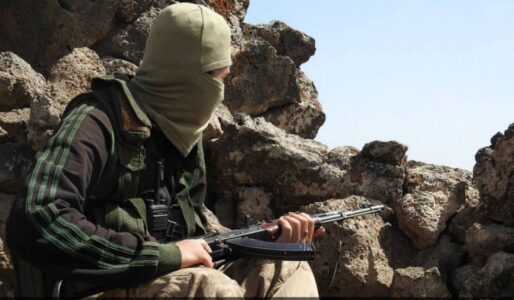
Islamic State’s Pakistan province launched new jihadist magazine
The first Urdu-language magazine of Islamic State’s Pakistan Province (IS-P) called Yalghar (Invasion) was published at the end of April 2021 on social media accounts that regularly disseminate IS-P propaganda materials. The magazine is IS-P’s first indigenous propaganda product.
IS-P propaganda materials have otherwise not been nearly as attractive and original as the materials of its parent group, IS Khorasan (IS-K) Province. Rather, IS-P has mainly translated Islamic State’s (IS) central propaganda materials from Arabic and English into Urdu.
IS central established IS-P in May 2019 by dividing IS-K into branches for India, Pakistan, and Afghanistan. Since then, IS-P has struggled to establish footholds in Pakistan and has not capitalized on local dynamics to receive support in the country (BBC Urdu, January 15).
The history of jihadist groups’ propaganda efforts in Pakistan shows that magazines have always been an effective part of their recruitment of potential support bases in the country. Although IS-P has not shown any significant presence in the urban centers of Pakistan, its propaganda efforts could provide it solid support in those areas in the long run.
For example, al-Qaeda unofficially released its first Urdu-language monthly magazine for Pakistan, Nawai Afghan Jihad (NAJ) (Voice of Afghan Jihad), in August 2008. Since then, NAJ has been published as an ‘independent’ jihadist magazine for Afghanistan and Pakistan.
The magazine quality improved with time and its propaganda content became highly sophisticated. Finally, in August 2019, al-Qaeda’s regional franchise, al-Qaeda in the Indian subcontinent (AQIS), which includes the South Asian region from Pakistan to India, Kashmir, Bangladesh, and Myanmar, formally declared NAJ as its official mouthpiece.
However, later evidence reveals that al-Qaeda’s senior Pakistani figures started NAJ and remained its founding figures in Pakistan after 9/11. Al-Qaeda strategically did not officially label NAJ as its own formal magazine despite that it promoted only al-Qaeda’s narratives in Pakistan.
Like Yalghar, NAJ’s first issue had only 16 pages of low-quality content. NAJ nevertheless helped al-Qaeda to channel highly educated Pakistani youth into its training camps in Waziristan.
Some of them later played central roles in turning NAJ into a sophisticated propaganda arm of the group in Pakistan, and NAJ remains al-Qaeda’s main trademark for Pakistan-related propaganda.
The 30-page Yalghar magazine has ten articles and an editorial and two infographics, which cover topics about IS in Pakistan, Afghanistan, and Syria. One infographic is about IS’ recent attacks in Pakistan and India, and the other is promoting a propaganda video series of IS.
The magazine encourages readers to send in their suggestions and articles through an e-mail given on its back page.
Five of the articles relate to the IS groups in Khorasan, Pakistan, and Syria, and the remaining articles are about IS ideology and Islamic history. Most of these contents were previously published by IS official media outlets in English or Arabic.
This first issue, however, lacks any engaging content about IS activities in Pakistan. The two articles related to IS-P are duplicates of old propaganda materials.
The first of the two articles include the IS-K founding emir Hafiz Saeed Khan Orakzai’s interview with the official IS English magazine, Dabiq, which was published in its thirteenth issue in January 2016.
The extract contains Orakzai’s general advice to IS members and supporters in Khorasan.
The second of the two articles is a transcript of an IS-P commander’s Urdu-language statement from a documentary released by the group’s Nida-i-Haq Urdu (Voice of the Truth) media center in January 2021 (Archives, January 12).
The video was about Hazara Shia coal miners who were brutally killed by the group on January 2 in Mach town of Pakistan’s southern Baluchistan province (Dawn, January 5). The only important information concerning IS-P was its recent assassination of senior Afghan Taliban commander, Naik Muhammad Rehbar, in the provincial capital of the Pakistan Khyber Pukhtoonkhawa Province (Militant Leadership Monitor, May 3).
Rehbar played a central role in rooting out IS Khorasan from Afghanistan’s Nangarhar province, which remain IS’ traditional stronghold (Arab News, April 20).
Like other IS-K and IS-P propaganda materials, this magazine also on several occasions included criticism of IS’ major regional jihadist rival, the Afghan Taliban, accusing its members of being stooges of the Pakistani spy agency, Inter-Services Intelligence (ISI).
Other than the Afghan Taliban, the magazine also criticizes IS’ global jihadist rival, al-Qaeda, for its silence over the arrests and suffering of IS female members in Syria after the group’s territorial caliphate collapsed in 2019. The magazine taunted those protesting Afia Siddiqui’s captivity in a U.S. prison, arguing that such people care only for one Muslim lady’s sufferings in the hands of “infidels” but have neglected thousands of others faced with more inhumane situations in Syria.
This propaganda could be particularly targeted against AQIS, which often protests Afia Siddiqui’s imprisonment and employs it as a regular theme in its propaganda materials for recruitment purposes.
A final article admits to IS’ losses in Afghanistan, claiming that the group lost its dominance and all its territories there, which it claims to have controlled for multiple years.
However, the author of the article boasts that a day will come when IS rises again in the country and will exact revenge on behalf of all of its slain and oppressed members.
Source: James Town





